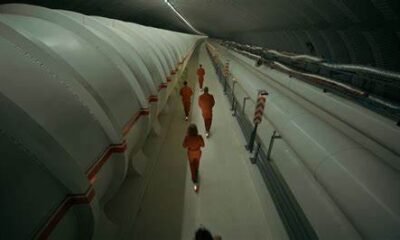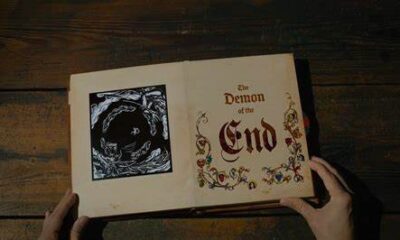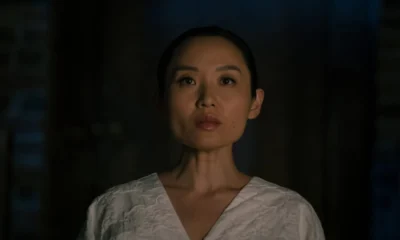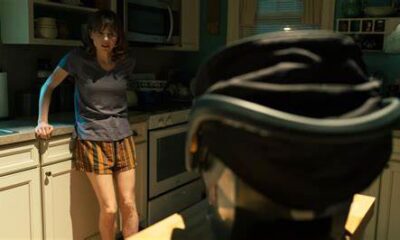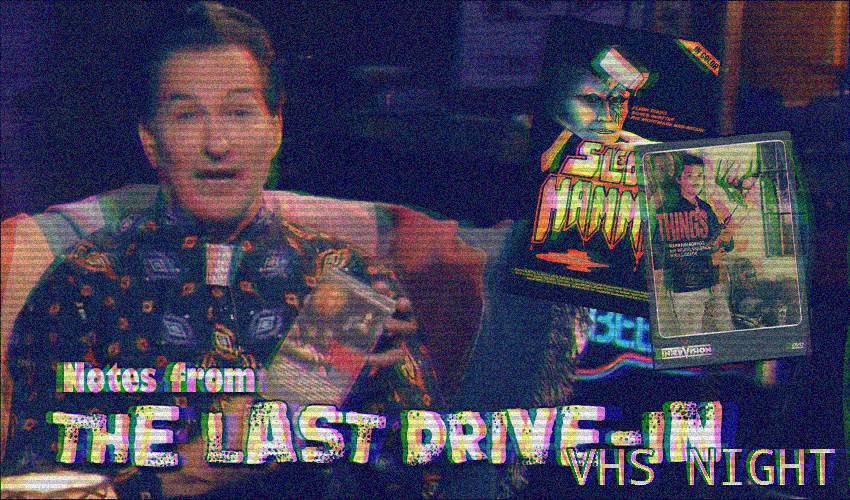
Notes from the Last Drive-In: S3E8 – Sledgehammer and Things
Welcome back to Notes from the Last Drive-In, where we discuss the 8th episode of season 3, featuring the cult “classic” films Sledgehammer and Things. I will be very critical of the movie selection for this episode – the films presented were amateurish, bad, and hard to watch movies. With that being said, though, they are also movies I feel I can treasure, and there is something genuinely valuable and charming about them, despite their flaws, like teeny, tiny diamond encrusted in a couple of inches of muck and dirt; unpleasant to dig through but ultimately rewarding. That’s kind of what you get with a VHS night, though.
Ultimately, it was a night of cinematic lows, but a wonderful night because of those lows. Thanks, Shudder.
Sledgehammer (1983)
Opening: The VHS Revolution and Joe Bob’s reason for VHS Night.
Bad slasher films far exceed the number of good slasher films, but Sledgehammer may be the reigning champ of awful in the genre. Written and directed by David A. Prior and shot entirely on VHS, Sledgehammer is, according to Joe Bob, said to be the first horror film produced entirely on VHS. Some argue it was 1982’s Boardinghouse, but our host suggests that because the taped film was transferred to actual film, the honor is dubious. The film stars Ted Prior, Linda McGill, John Eastman, and Jeanine Scheer, though most of the cast had minimal careers at best. Ted Prior is best known for the direct-to-VHS Deadly Prey (1988), a Rambo-knockoff, and bit-part in Surf Nazis Must Die (1987).
The film follows a group of friends who decided to spend their time partying in a house that was the site of a murder mystery a decade earlier. Before long, they participate in a prank séance that summons the vengeful ghost of a boy locked in a closet by his abusive mother shortly before her murder. Naturally, the bodies start piling up. However, the plot is a mess, and the story throws bizarre, inconsistent elements on screen. The killer has strange, arbitrary rules that are jettisoned in an instant. There is a suggestion of a Satanic ritual that serves no real purpose to confuse the overall story. Even worse, the film suggests the child who was locked in the closet went missing, yet his remains are found in that same closet ten years later during the course of the film.
The whole film has a pseudo-improvised quality to it. A story doesn’t so much unfold rather than exists as a series of moments, some of which suggest a possible narrative while others feel like ideas had on the day of the shoot, such as the infamous “food fight” sequence, which may be the most horrifying moment in the movie. Furthermore, the performances are amateurish and exaggerated. Every line read has an odd cadence that makes even simple lines sound unnatural. The killer, the largest draw of a slasher film, is a lazy trope, a masked figure with a common tool used to kill. The plastic mask makes no sense, either; perhaps if it was something the kid wore before he died, there might be a reason to include it, but it is an arbitrary and laughable choice in the film as it exists.
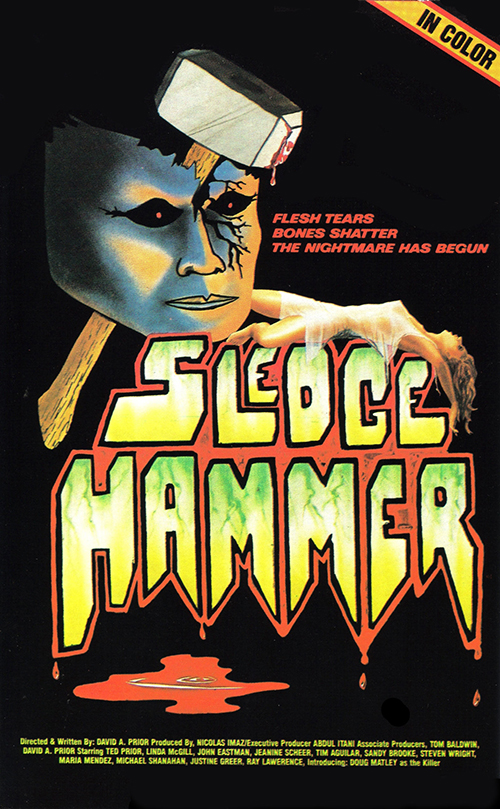
I could continue to criticize the film easily. However, something about it ended up being quite fun. It isn’t a good movie by any reasonable metric – yet I enjoyed my time with it. That begs the question of how we define a “good” movie, though, doesn’t it? Joe Bob’s commentary throughout the night articulates that idea to a degree. The film is not technically good, but it exists. It is the effort of someone genuinely having fun and making something, and we are partaking in that joy. It may not be in the way intended by Prior, but here we are, over 30 years after Prior’s friends made it, watching it as a community and pulling something from it. It’s not unlike The Room or that Monkey Christ incident where we see the earnestness of the intent and do find a kind of enjoyment in bearing witness to it, though the quality itself may be lacking or laughable.
Perhaps the highlight of the host segments was discussing the VHS form and aesthetic, particularly why there is something so comforting about them. Essentially, Joe Bob reasons that there is something about the “dot pattern that lulls you into a comfort zone” of familiarity. When we watch such VHS horror, we find ourselves reading them as home movies in a way, and can project people we know into the film. This is definitely part of that larger communal reading.
Among some of the other fun bits during the host segments, we learn a fun assemblage of the history of the film – in one of the more impressive feats, Prior shot it in a two-bedroom house. Yet, it ends up feeling much larger in the final film, mostly due to a baffling number of door opening sequences, I suspect. There was also a fun history of aerobic-themed horror films, which frankly sounds like a nice double-feature for season four. Of course, there was also some of that classic poking of fun at academia and horror, which I have grown immune to – it is always a fun time when Joe Bob mentions semiotics.
It is hard to rate a movie like Sledgehammer where the end product is bad, but you enjoy it. Joe Bob gave it two-and-a-half stars, even noting he was being “generous.” His rating, I feel, reflects that dichotomy of recognizing the movie is bad but still finding enjoyment from it. I guess if I had to force a food metaphor if most of the movies on The Last Drive-In are junk food, Sledgehammer is like that gas station taquito you can’t help eating once a month. So while I can only give this movie a one out of five Cthulhus when it comes to the quality of the film, it is certainly worth experiencing at least once.
 (1.5 / 5)
(1.5 / 5)
Best Line: “BLARGHARBLE.” – Chuck’s “Bill Murray” Impression
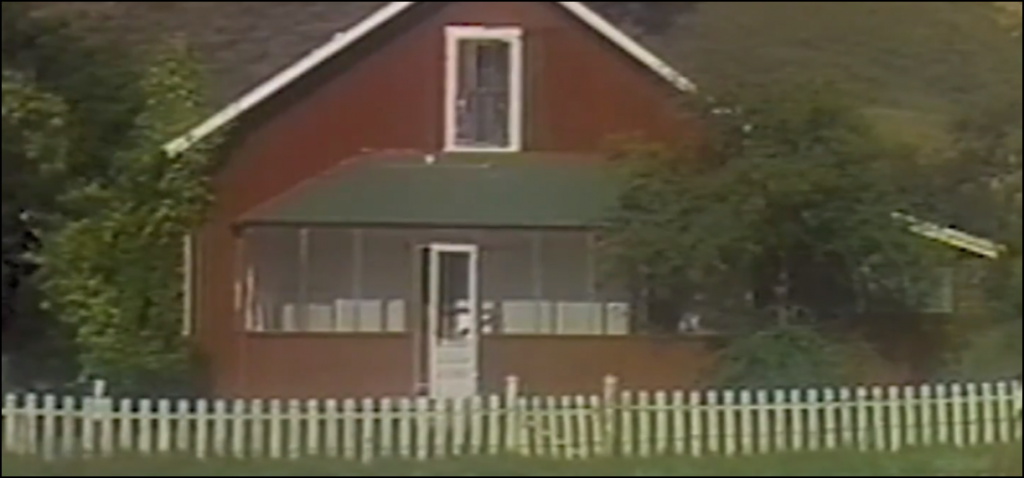
Things (1989)
Opening: We’re about to go on a trip.
Muddy and dimly lit. Tinny and grating dubbing. Incoherent and minimal story. This is the infamous “classic” Things. But, believe it or not, The Last Drive-In can dig deeper and find an even worse movie for the back half of the night. This Canadian independent horror film, already a sign of danger, was shot direct-to-video – specifically on Super 8. Directed by Andrew Jordan, who co-wrote it with Barry J. Gillis, the movie stars Barry J. Gillis, porn star Amber Lynn, Bruce Roach, and Doug Bunston.
The film follows two friends who visit a friend’s cabin, only to uncover a horrific experiment… I think? The plot of Things is tough to discern for many reasons. Perhaps the best description of the intended plot I could find is on IMDB:
An impotent husband, driven by a fanatical desire to father children, forces his wife to undergo a dangerous experiment. The result: the birth of a multitude of monstrous THINGS.
There is a story to be found, but the film takes every opportunity it can not progress the story. First, long sequences of poorly dubbed conversations, cheese sandwich making, and wandering around darkened rooms with a flashlight. These long stretches are periodically punctuated by Halloween prop ants or some ham-fisted gore effect. Then, of course, there are the Amber Lynn sequences that have no plot relevance – where she plays a news reporter sitting in front of an A/V shelf, reading cue cards that are obviously off to the side of the camera.
The movie has so many problems that talking about them would just come off as bullying someone who cannot fight back. Such as the case with one character vanishing for well over a half-hour of the runtime because Bruce Roach couldn’t be on set. With that being said, I do feel I need to point out the absolutely hilarious dub. Much like that MST3K classic, Manos: The Hands of Fate, Things is entirely dubbed over. Unlike Manos, which the crew was unable to record audio when it was shot due to the lack of sound equipment, Things had to be dubbed over because of too much talking on set. This is important as to why Things, as bad as it is, is ultimately compelling. With that being said, the dub on Things is awful in the most hilarious way imaginable – line reads are frequently slurred, rushed through, or completely inappropriate to what is going on. Even better is when a line is spouted, which was obviously added in post, such as Don’s hilarious bitching about the weight of his friend or maple syrup references.
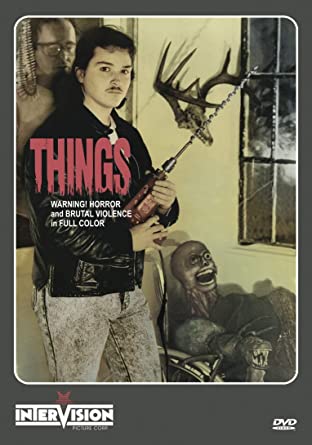
Joe Bob’s host segments featured a special appearance by a friend of the Drive-In and AEW superstar Chris Jericho, likely future recipient of his own dedicated land-line for Canadian horror. He’ll be the next Felissa Rose on the show, only consulting on canucks rather than mangled dicks. Jericho’s interview segment was by far the most naturalistic of the season, and his utter contempt for Things was quite funny. However, his attempts to disown the film as a product of Canada are not likely to pan out. Outside of this, most of the segments would begin with a series of questions attempting to parse the film’s meaning and what was seen on screen. Unfortunately, few of the answers were found. Some of the factoids worked their way in from the confused delirium: how exactly Amber Lynn became involved (they asked her) and who the nude woman was (a sex worker).
Joe Bob’s impassioned speech at the end of the episode is key to the night. Both films are rightly terrible, with Joe Bob giving Things a one-star rating. Things seems to be the only movie on the show so far that has earned that dubious honor. Yet, as Joe Bob says in the conclusion of the night, the evening was a celebration of the little guy. Things is a movie that exists, a tangible thing made by someone outside the traditional pipeline of film. It is far from competent, but at least someone poured their passion into it. It is easy to judge a film as bad, but it is quite another to actually make an independent film, which should be celebrated when it happens. As for my own rating from quality alone, I would only give the film one of five Cthulhus. However, much like Sledgehammer, I am glad to have seen it.
 (1 / 5)
(1 / 5)
Best Line: “Susan! They ate her down to the skull!” – Don, upon seeing the Things have eaten Susan down to the skull.
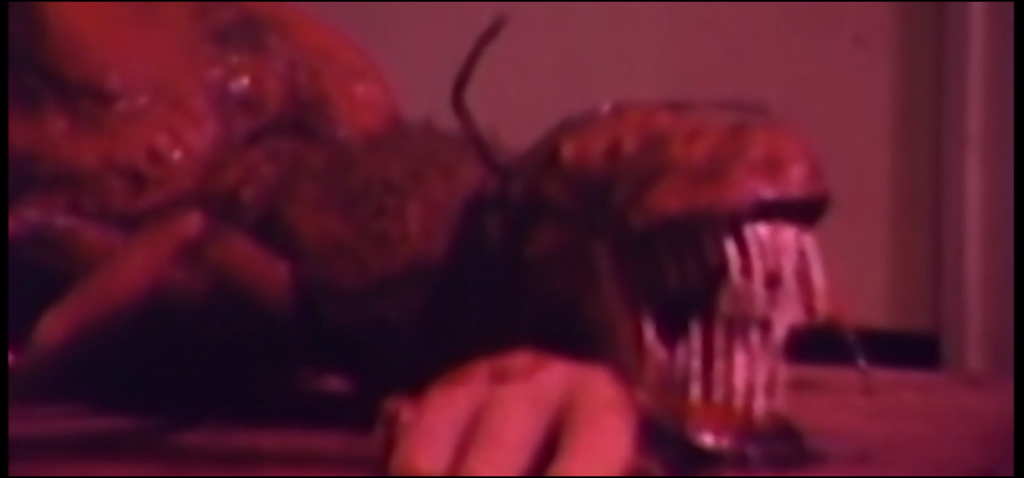
Haunted MTL Drive-In Totals
Of course we are going to include the standard Drive-In Totals, as shared by the Shudder Twitter account.
And as for our totals we have:
- 2 mailbag entries
- “$350,000” Budget
- The 8th dead dog of the season
- 4 breaks per movie
- 37 David Prior movies
- Gratuitous Canadian references
- “Creepy Neighbor” caps
- Tracking Fu
- Existential Questioning about what we are seeing Fu
- Yuki sighting
- Spontaneously disappearing actor
- Silver Bolo Award: SOV Horror
- Darcy Cosplay: Sledgehammeress and Blockbuster Darcy
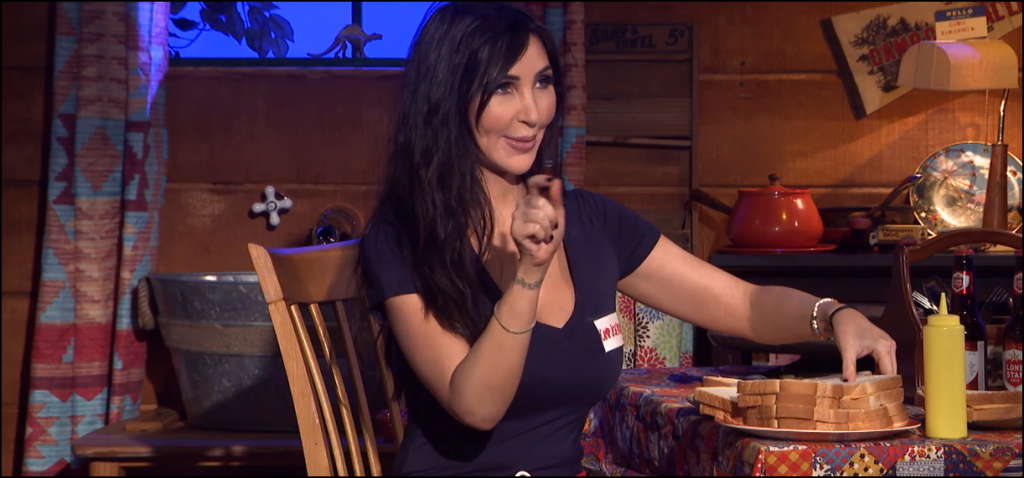
Episode Score
The movie selection tonight was terrible, yet the episode is larger than the sum of its parts. I hope that VHS night becomes a thing every season as there are so many VHS films out there that could easily find their way into the show. I think a celebration of the earnest but incompetent is something we could benefit from as horror fans from time to time. With any luck, nights like this might inspire someone to make their damn movie. The average mutant carries an entire film studio on their phone these days. Perhaps a few years down the line, they will be talking about the Mutant Renaissance?
Anyway, one star movies but a five star night. I give this episode of The Last Drive-In five out of five Cthulhus.
 (5 / 5)
(5 / 5)
And with that, I am out. Join us on Twitter next week as we live-tweet the penultimate episode of the season. It’s gonna be a good time.
Movies n TV
Wheel of Time A Question of Crimson Is a Political Espionage Delight
Episode two of Wheel of Time felt like the beginning of a long journey. Stories are unfolding, lives are changing, and blood is spilling.
Let’s discuss.
The story
We begin this episode in the past with Elayne’s mother, Queen Morgase. It turns out her rise to the throne was a bit, shall we say, cutthroat. So when she shows up at the White Tower, Siuan is concerned.
She might have reason to be, too.
Meanwhile, Rand, Egwene, Moiraine, Lan and Aviendha are in the Spine of The World. As they travel through some of the most breathtaking lands I have ever seen on a TV show, Egwene is plagued with nightmares. We think at first that’s just her trauma working itself through her system. But we soon find out that it might not be that straightforward.
Finally, Perrin returns home to heal after his hand is almost cut in half. But when he gets there he finds the town has been infested by Children of The Light. And they’re looking for him.
What worked
There was something heartwarming in this episode about political espionage and choking religious persecution. And that is Elayne’s relationship with her family.
I have consumed a lot of fantasy content with royal families. And I have never once heard a princess call her mother ‘Mum’. I’ve never seen royal siblings get along. And I have sure as hell never seen a princess have a good relationship with her step-parent.
This was refreshing. Even though Queen Morgase is kind of a horrible person she seems like a good mother. And that’s an unexpected delight.

Of course, this is just one storyline among many. And while this can sometimes be overwhelming, in this case it wasn’t.
I’ll be honest, some of these storylines are going to drag for me. I know this because I’ve read some of the Wheel of Time books and I have an idea that not all the characters exactly pique my interest.
No one likes all the characters. No one likes all the storylines. While I am here for the political espionage between Queen Morgase and Siuan, not everyone likes it. While others might be fascinated with Selene trying to win Rand back, I couldn’t care less.
Having multiple storylines keeps everyone’s attention better. So long as things don’t get out of hand. Things can easily get out of hand. But this seems to be managed well.
So far.
What didn’t work
As I mentioned above, I’m not thrilled with Rand’s story at this point. And while it’s fine to not like a storyline when there are this many to choose from, it’s not fantastic that the one I like the least is the one involving our two main characters. And anytime we were with the team at the Spine of The World, the only thing that brought me joy was Moirain’s hat. It reminded me of Stockard Channing’s hat in Practical Magic.
The problem is that Rand is Charlie Brown with controversial magical powers. He is boring, serious, and pessimistic.
And yes, I understand that he has a heavy emotional burden and he’s the Dragon Reborn and that’s quite taxing and all. But let’s be fair, there isn’t a single person in this show that doesn’t have a heavy burden. And most of them manage to be fun occasionally.

All that being said, this episode of Wheel of Time did exactly what it needed to do. It set up conflicts at each of the three locations. It established emotional ties between the characters and the events. And it established goals for everyone.
This was, in short, a solid episode. Not groundbreaking, not mind-blowing or life changing. It was simply good. It was entertaining and moved the plot forward.
Well done.
 (3.5 / 5)
(3.5 / 5)
Movies n TV
Wheel of Time Returns With A Bang
Wheel of Time is back for season three. There are mixed feelings regarding this. Last season, there were some serious pacing issues. And some serious sticking to the book’s storyline issues. But we’re two seasons in, and we don’t give up so easily. So let’s dive into episode one, To Race the Shadow.
By the way, I highly recommend watching this episode with the subtitles on. You’ll see why.
The story
We begin this episode with Liandrin facing a trial of sorts for her rampant betrayal. She does her best to gaslight her Aes Sedai sisters into thinking that Siuan Sanche is the real traitor.

When that doesn’t work, she reveals how many Black Aes Sedai have actually infiltrated the tower.
Spoiler, it’s a lot.
In the aftermath, our whole team gathers to drink and enjoy one night of relaxation before they head out to the Tear to form an army for Rand. All is going well until they’re attacked by myriad creatures and a sentient axe.
What worked
This episode was long. It had a run time of an hour and eleven minutes. And a lot of that run time was spent in heavy dialog scenes.
Fortunately, these were well-done scenes.
If you’re going to have a lot of talking scenes, there are good ways and bad ways to do it. Last season, we saw lots of examples of the bad way to do it. But this episode did it well. For one thing, other things were going on while conversations were taking place. The characters are drinking, playing games, walking through an interesting city. And the scenes themselves didn’t stretch out. They weren’t repetitive. We heard what the character had to say, then we moved on.
It was also nice that the point of these scenes wasn’t just info dumps. We had character development. We had romantic interactions. We had plot development and foreshadowing.
Overall, this episode felt like what it was. A moment of calm before a storm.
Taking a step back, I’d be remiss if I didn’t address the fight scene at the start of the episode. Because it was epic.
The magic looked amazing. The martial arts that went along with it looked fantastic. The costumes were beautiful. It was just incredibly fun to watch.
More than that, it was emotional. We lost some characters in that fight that were important. And it was clearly emotionally shattering for many of our characters, who found themselves betrayed by people they trusted.
So many of them.
It was a great way to open the season.
What didn’t work
Despite that, this episode wasn’t without its flaws.
First off, there were a lot of dialog scenes. And they were good scenes, as I’ve already discussed. But it was one after another after another. And when your episode is, again, an hour and eleven minutes, it’s maybe a little much to have so much chit-chat. Couldn’t some of these conversations, important as they were, have been moved to maybe another episode?
Finally, I want to talk about Egwene’s travel through the arches.

I feel like maybe there were some deleted scenes here. Because there must have been more to that visit than what we saw, right?
We could have seen Egwene battle Rand. That would have been badass and emotionally devastating. We could have seen her with a quiet life with Rand back home at the Two Rivers. We could have seen anything except for the quick clip of Rand in a bloody river, followed by Egwene being shoved back out in a bloody shift.
Bad job. But at least it wasn’t an extended scene of Moiraine collecting bathwater, and then taking a bath while looking sad. If we’d started this season with another scene like that, it might have broken my brain.
Amazon dropped the first three episodes at once. So we’ll be back soon to talk about episode two. See you then.
 (4 / 5)
(4 / 5)
Movies n TV
Entertaining as hell: Eight Legged Freaks (2002) Review
Early 2000s is a special era for the industry. It accepts the cheesiness and corniness of movie making, in turn producing some gems in their own right. Eight Legged Freaks starring David Arquette and young Scarlet Johanson is a horror comedy about giant spiders who overtake a small town. As crazy as that premise sounds, the movie surprisingly has a ton of heart and is super entertaining. Let’s review, shall we?
Plot
We start Eight Legged Freaks with a shot of toxic waste spilling into the water supply of Joshua, a spider farm owner. He is friends with Mike, one of our protagonists, who is a science geek and a spider enthusiast. Mike notices something quite right upon visiting Joshua, but no one takes him seriously. We are then introduced to the rest of the crew. Mike’s mother Samantha, the town sheriff, is too busy chasing Ashley, his sister, who is dating the town mayor’s son Bret (something Samantha does not approve of). We also have Chris, who returns to the town to save his father’s legacy in the town mines. He has opposition from Wade, Bret’s father, who wants to use the mines for his business ventures. Lots of drama going on that will only get juicier once the spiders get loose.
The creepy crawlies quickly dispose of Joshua and make their grand appearance after Ashley rejects Bret’s advances, abandoning him in the middle of a desert. A glorious chase sequence ensues as the spiders make their way towards the town, wreaking havoc on its residents. In a true horror fashion (which the movie acknowledges), it takes some convincing from Mike and then from Samantha for the town to take the threat seriously. The tongue-in-cheek style of narrative adds the comedy aspect to a movie that would otherwise burn out fairly quickly.
The remaining characters hide out in a shopping mall as it’s the only somewhat sturdy building in the area. This doesn’t last long as the spiders break in, forcing them to run through the mines. Their resources to fight the creepy crawlies off are limited as the methane gas doesn’t allow them to use firearms. Such conditions require resourceful thinking from Chris, who uses perfume to fend off the leader of the spider group and save himself during the climax of the movie.
Character dynamics are not forgotten once the action kicks in. We have Chris confessing his long-term feelings for Samantha which she knew all along, which provided some comedic relief. Bret also reunites with Ashley and apologises for being an asshole. Mike finally gets the appreciation he deserves as his knowledge saves the townsfolk more than once during the whole ordeal.
We end the movie with the town’s radio show person telling the story as an urban legend during his segment. This brings it into question – how much of it happened the way he said it did? We can only guess…
Overall thoughts
Eight Legged Freaks is a fun creature feature with some self-aware commentary on genre tropes that doesn’t take itself too seriously. The acting is good, the pacing fitting and the characters are likeable enough for you to want them to make it through. Definitely a must watch, if you don’t suffer from arachnophobia, that is.
 (5 / 5)
(5 / 5)


